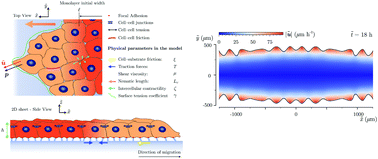Fingering instability in spreading epithelial monolayers: roles of cell polarisation, substrate friction and contractile stresses
Abstract
Collective cell migration plays a crucial role in many developmental processes that underlie morphogenesis, wound healing, or cancer progression. In such coordinated behaviours, cells are organised in coherent structures and actively migrate to serve different biological purposes. In some contexts, namely during epithelial wound healing, it is well known that a migrating free-edge monolayer develops finger-like instabilities, yet the onset is still under debate. Here, by means of theory and numerical simulations, we shed light on the main mechanisms driving the instability process, analysing the linear and nonlinear dynamics of a continuum compressible polar fluid. In particular, we assess the role of cell polarisation, substrate friction, and contractile stresses. Linear theory shows that it is crucial to analyse the perturbation transient dynamics, since we unravel a plethora of crossovers between different exponential growth rates during the linear regime. Numerical simulations suggest that cell–substrate friction could be the mechanism responsible for the formation of complex finger-like structures at the edge, since it triggers secondary fingering instabilities and tip-splitting phenomena. Finally, we obtain a critical contractile stress that depends on cell–substrate friction and the initial-to-nematic length ratio, characterising an active wetting-dewetting transition. In the dewetting scenario, the monolayer retracts and becomes stable without developing finger-like structures.

- This article is part of the themed collection: Soft Matter Most Popular 2021


 Please wait while we load your content...
Please wait while we load your content...